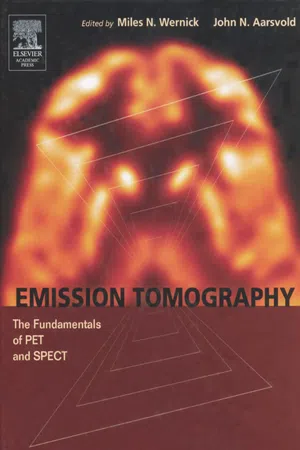
Emission Tomography
The Fundamentals of PET and SPECT
Miles N. Wernick,John N. Aarsvold
- 596 páginas
- English
- ePUB (apto para móviles)
- Disponible en iOS y Android
Emission Tomography
The Fundamentals of PET and SPECT
Miles N. Wernick,John N. Aarsvold
Información del libro
PET and SPECT are two of today's most important medical-imaging methods, providing images that reveal subtle information about physiological processes in humans and animals. Emission Tomography: The Fundamentals of PET and SPECT explains the physics and engineering principles of these important functional-imaging methods. The technology of emission tomography is covered in detail, including historical origins, scientific and mathematical foundations, imaging systems and their components, image reconstruction and analysis, simulation techniques, and clinical and laboratory applications. The book describes the state of the art of emission tomography, including all facets of conventional SPECT and PET, as well as contemporary topics such as iterative image reconstruction, small-animal imaging, and PET/CT systems. This book is intended as a textbook and reference resource for graduate students, researchers, medical physicists, biomedical engineers, and professional engineers and physicists in the medical-imaging industry. Thorough tutorials of fundamental and advanced topics are presented by dozens of the leading researchers in PET and SPECT. SPECT has long been a mainstay of clinical imaging, and PET is now one of the world's fastest growing medical imaging techniques, owing to its dramatic contributions to cancer imaging and other applications. Emission Tomography: The Fundamentals of PET and SPECT is an essential resource for understanding the technology of SPECT and PET, the most widely used forms of molecular imaging.*Contains thorough tutorial treatments, coupled with coverage of advanced topics
*Three of the four holders of the prestigious Institute of Electrical and Electronics Engineers Medical Imaging Scientist Award are chapter contributors
*Include color artwork
Preguntas frecuentes
Información
Imaging Science: Bringing the Invisible to Light
I PREAMBLE
II INTRODUCTION
Índice
- Cover image
- Title page
- Table of Contents
- Copyright
- Contributors
- Foreword
- Preface
- Acknowledgments
- Chapter 1: Imaging Science: Bringing the Invisible to Light
- Chapter 2: Introduction to Emission Tomography
- Chapter 3: Evolution of Clinical Emission Tomography
- Chapter 4: Basic Physics of Radionuclide Imaging
- Chapter 5: Radiopharmaceuticals for Imaging the Brain
- Chapter 6: Basics of Imaging Theory and Statistics
- Chapter 7: Single-Photon Emission Computed Tomography
- Chapter 8: Collimator Design for Nuclear Medicine
- Chapter 9: Annular Single-Crystal Emission Tomography Systems
- Chapter 10: PET Systems
- Chapter 11: PET/CT Systems
- Chapter 12: Small Animal PET Systems
- Chapter 13: Scintillators
- Chapter 14: Photodetectors
- Chapter 15: CdTe and CdZnTe Semiconductor Detectors for Nuclear Medicine Imaging
- Chapter 16: Application-Specific Small Field-of-View Nuclear Emission Imagers in Medicine
- Chapter 17: Intraoperative Probes and Imaging Probes
- Chapter 18: Noble Gas Detectors
- Chapter 19: Compton Cameras for Nuclear Medical Imaging
- Chapter 20: Analytic Image Reconstruction Methods
- Chapter 21: Iterative Image Reconstruction
- Chapter 22: Attenuation, Scatter, and Spatial Resolution Compensation in SPECT
- Chapter 23: Kinetic Modeling in Positron Emission Tomography
- Chapter 24: Computer Analysis of Nuclear Cardiology Procedures
- Chapter 25: Simulation Techniques and Phantoms
- Index